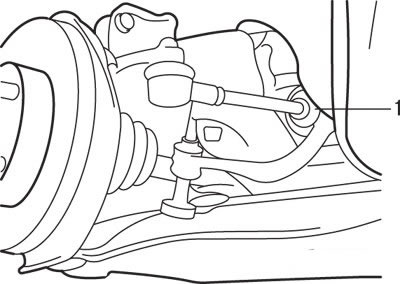Before measuring the front wheel alignment, park the vehicle on a level, level surface. Before adjustment, check that the front suspension, steering and wheels are in good technical condition.
Front wheel alignment

Pic. 15.23. Clamp Location (1) tie rod boot mountings
If the toe-in does not correspond to the nominal value, then adjust the toe-in as follows: loosen the tie-rod boot clamps and rotate the right and left tie-rods at equal angles in opposite directions (pic. 15.23).
The toe-in will decrease when the left tie rod is rotated towards the front of the vehicle and the right tie rod is rotated towards the rear.
One turn of the left and right tie rods results in a toe change of approximately 0°35' (on one wheel).
Negative toe-in of steered wheels when turning
In addition to checking the toe-in of the front wheels, it is recommended to check the reverse toe-in of the steered wheels when cornering, especially in cases where the car has been in an accident or it is likely that the car has been in an accident. Carry out this check at left and right turns.
Camber, longitudinal and transverse inclinations of the axis of rotation
Front camber and caster are factory set and cannot be adjusted during operation.
If the front camber is not within specification, check the front suspension assemblies and replace any deformed or damaged parts.
For vehicles with aluminum rims, use a special mount to install a sensor on the drive shaft to check the angles of the steered wheels. Tighten the special fastener with the same torque as the drive shaft fastening nut (200–260 Nm).
Attention! It is forbidden to load the bearing of the front wheel hub with the weight of the car when the drive shaft fastening nuts are loosened.
